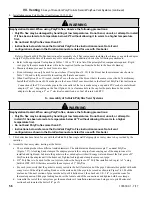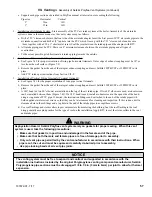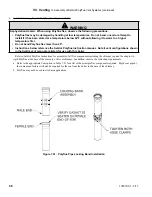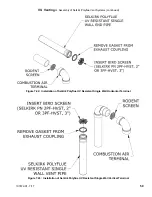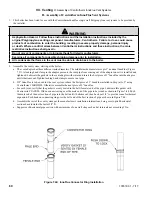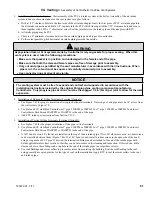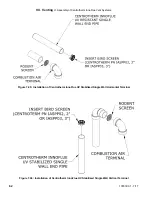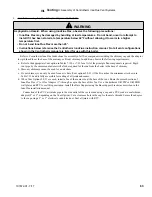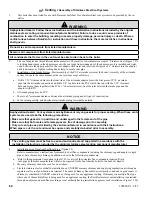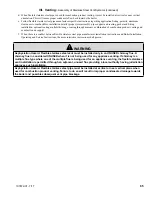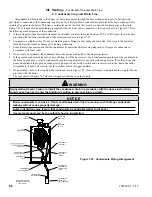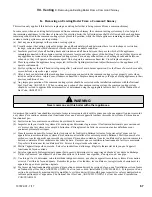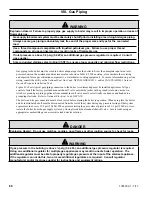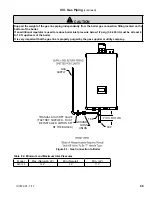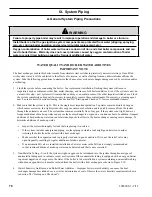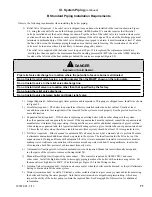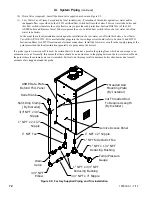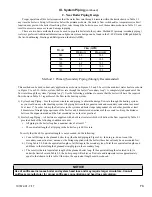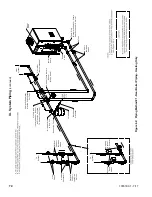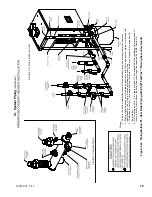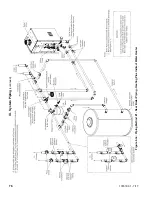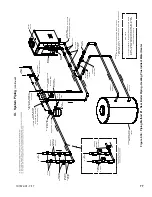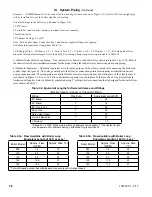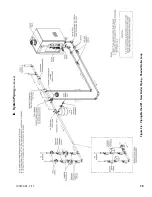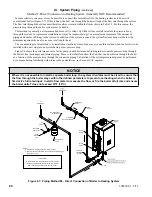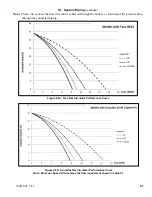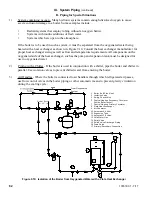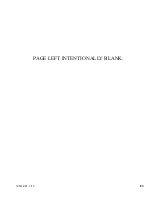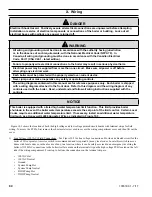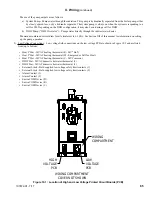
70
107672-01 - 7/17
IX. System Piping
A. General System Piping Precautions
Warning
Failure to properly pipe boiler may result in improper operation and damage to boiler or structure.
Install boiler so that the gas ignition system components are protected from water (dripping, spraying,
rain, etc.) during boiler operation and service (circulator replacement, etc.).
Oxygen contamination of boiler water will cause corrosion of iron and steel boiler components and can
lead to boiler failure. Warranty does not cover problems caused by oxygen contamination of boiler
water or scale (lime) build-up caused by frequent addition of water.
WATER QUALITY AND BOILER WATER ADDITIVES
IMPORTANT NOTE
The heat exchanger used in this boiler is made from stainless steel coils having relatively narrow waterways. Once filled
with system water, it will be subjected to the effects of corrosion, as well as fouling from any debris introduced from the
system. Take the following precautions to minimize the chance of severe heat exchanger damage caused by corrosion and/or
overheating:
1 Flush the system before connecting the boiler - In a replacement installation, flushing the system will remove
impurities, such as sediment, solder flux, metal shavings, and traces of old boiler additives. Even if the system is new, do
not omit this step – new systems will contain flux and may even contain some of the other impurities listed above. Flush
the system completely and repeat if necessary to completely remove these contaminants. If necessary, a cleaning agent
may be used to assist in system cleaning. See Section XI (“Start-up and Check-out”) for recommended cleaners.
2. Make sure that the system is tight - This is the single most important guideline. Tap water contains dissolved oxygen
which causes corrosion. In a tight system, this oxygen comes out of solution and is quickly removed from the system
through the automatic air vent. The system then remains essentially free of oxygen. If the system is not tight, however,
frequent additions of make-up water can expose the heat exchanger to oxygen on a continuous basis. In addition, frequent
additions of hard make-up water can cause calcium deposits to collect in the heat exchanger, causing severe damage. To
minimize additions of make-up water:
• Inspect the system thoroughly for leaks before placing it in service.
• If the system includes underground piping, or other piping in which a leak might go undetected, consider
isolating the boiler from the system with a heat exchanger.
• Make sure that the expansion tank is properly sized and in good condition. If it is not, the relief valve may
open frequently, resulting in regular additions of make-up water.
• If an automatic fill valve is installed, installation of a water meter in the fill line is strongly recommended
so that routine additions of make-up water can be detected and their cause corrected.
3. Non-Metallic Tubing - Even if the system is tight, oxygen can be introduced into the system through some types of
non-metallic tubing used in radiant or snow melt systems. Other nonmetallic tubing is equipped with an oxygen barrier
to prevent migration of oxygen into the water. If the boiler is to be installed in a system containing non-metallic tubing
without an oxygen barrier, it must be isolated from the boiler with a heat exchanger as shown in Figure 9.10.
4. Water Chemistry, Antifreeze, and Boiler Water Additives – Improper boiler water chemistry can cause the heat
exchanger damage described above, as well as deterioration of seals. Observe the water chemistry requirements shown
in Section XI (“Start-up and Check-out”).
Summary of Contents for K2WT-080B
Page 83: ...83 107672 01 7 17 PAGE LEFT INTENTIONALLY BLANK...
Page 89: ...89 107672 01 7 17 X Wiring continued Figure 10 5 Internal Ladder Diagram...
Page 90: ...90 107672 01 7 17 X Wiring continued...
Page 91: ...91 107672 01 7 17 Figure 10 6 Internal Wiring Connections Diagram X Wiring continued...
Page 102: ...102 107672 01 7 17 Lighting and Operating Instructions XI Start Up and Checkout continued...
Page 147: ...147 107672 01 7 17 XV Service Parts continued...
Page 151: ...151 107672 01 7 17 XV Service Parts continued...
Page 153: ...153 107672 01 7 17 XV Service Parts continued 85 86 91 95...
Page 162: ...162 107672 01 7 17...
Page 163: ...163 107672 01 7 17...
Page 164: ...164 107672 01 7 17...
Page 165: ...165 107672 01 7 17...
Page 166: ...166 107672 01 7 17...
Page 167: ...167 107672 01 7 17...

